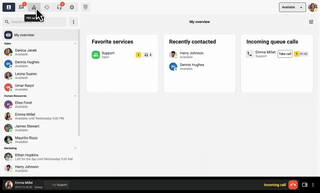SIP trunking and VoIP are two terms that are widely talked about and related to each other but maybe not in the way you thought. The world of telephony is full of abbreviations and terms that are similar and it’s easy to get them confused. Here we explain the terms and how voice calls over the internet are related!
What is VoIP?
VoIP (Voice over Internet Protocol) is a broad term that encompasses all voice calls over the internet, it is not part of the public telephone network. VoIP converts analog phone calls into digital signals that are sent over the internet.
Within all these telephone calls there are a number of protocols, SIP being the most common. It is therefore one of several protocols that make VoIP possible. VoIP can also be referred to as IP telephony, broadband telephony and internet telephony. Whatever it is called, it refers to the technology that enables online voice calls.
How does VoIP work?
To use VoIP, you need some type of VoIP phone that makes calls over the internet. When you make a call, VoIP takes an analog voice signal and compresses it into a digital signal that is then sent over the internet as data. A VoIP call only goes over the internet or a private internal network.
Two types of VoIP phones
A VoIP phone can be used in different ways, but whether it’s hardware or software, it involves calls going over the internet. You can use a VoIP phone to make calls to other VoIP phones, landlines or mobile phones.
- VoIP in a landline phone
- VoIP in mobile phones or computer (softphones)
The simplest form is VoIP phones, which work in much the same way as a regular phone, but they are connected to your computer directly through, for example, USB or wireless. This can be a good solution for example in a conference room or in your reception.
VoIP can also be customized as a software program you use on your computer or as an app on your mobile phone. The software on your computer will set up a direct connection (P2P) to the computer you are calling when you make a call.
A SIP phone is a synonym for a VoIP phone or a softphone.
What is SIP?
SIP stands for Session Initiation Protocol and is a communication protocol that is the industry standard for use by most types of VoIP deployment. A protocol, in this context, is a system of digital rules that allows devices to communicate. SIP is thus more of a product and service for making calls over the internet.
VoIP calls are a type of session that SIP can handle and SIP is just one of many protocols that can be used to implement VoIP, just as HTTP underpins web pages.
How does SIP work?
SIP uses VoIP to send information over the internet or intranet. Instead of the traditional copper wires, you use a SIP trunk line for calls of various kinds. A SIP trunk accommodates several SIP channels and each channel works like a regular phone line.
You only need one SIP trunk as it can handle any number of channels. The number of SIP channels is easily scaled up and down based on how many calls you make. A SIP trunk can be used to transmit data packets over any network, i.e. the internet, ISDN (physical telephone network) or VPN.
SIP trunks allow you to make calls over the internet to anyone – whether they use VoIP or PSTN. For SIP trunking to work, your PBX must be SIP-compatible and you must have a fast enough internet connection.
How does SIP relate to IP?
IP (Internet Protocol) is also a type of protocol but it is more generally about sending information over the internet. If IP symbolizes the road you drive on the internet, SIP is the type of transport you use on the road, like bus or car, to make a call over the internet.
How are VoIP and SIP trunks related?
In general terms, both VoIP and SIP trunk are concepts of making calls over the internet instead of using jack in the wall and copper wires. It can be said that VoIP is a technology or concept for telephony over the internet, while SIP is a service.
If you are calling using VoIP, SIP is the framework for how the call is connected. If you have a phone at one end and another phone at the other, both points need to know how to communicate with each other. SIP is then the language they use to talk to each other. VoIP is the call itself.
SIP trunking is part of the same network your calls go over. The protocol is stored in the telephone exchange you have in your building and on the internet service provider’s equipment. VoIP calls are instead controlled from a central location by a separate provider who controls the traffic. It is not as secure and means that if the system goes down, you have no call functionality.
You can use VoIP without SIP trunking, but not SIP trunking without VoIP. SIP enhances VoIP so you can communicate via multimedia, be it video conferencing, text or files. Without SIP, VoIP is just voice calls over the internet.

Future-proof, flexible and scalable solutions
Using VoIP with or without SIP offers both the same types of general benefits. Among the best is that it is future-proofed. The internet will definitely be around in 100 years, but perhaps in a different guise. Either way, there will be a way to connect calls this far into the future.
The alternative, to continue using the physical copper lines and the old PSTN is something that is being phased out in many parts of the world. This is because it is expensive to maintain and uses old technology.
Calling online also comes with a lot of cost benefits. By using the internet instead of a specific operator’s lines (on which they have maintenance costs), it becomes cheaper to use both SIP trunking or just a VoIP solution. You also reduce the overall cost of calls as you are making free calls over the internet.
It’s also scalable, as you don’t have to run wires and don’t need specific phone jacks. Instead, you can use the internet sockets and the same wireless network you use for your computers. You also get a completely different flexibility as you are not dependent on being in the office to take calls, but you can work from wherever you want.
VoIP, SIP trunking or UCaaS – what’s best?
VoIP is really suitable for everyone and most people use VoIP to some extent. If you make a private call over Zoom or have a customer meeting in Microsoft Teams, it is VoIP you use. VoIP is therefore suitable for companies of all sizes and industries as a complement to other telephony services. However, a disadvantage of solutions such as Skype and Teams is that it requires the person you are talking to to have the software installed on their computer or mobile phone.
To decide which solution is best for you, you need to think about your communication needs. Are you a smaller company with a smaller need for solutions and functions and which mainly makes voice calls? Then a simple VoIP solution to complement your telephone exchange, without SIP trunking, may be enough. But if you are in a growth phase or see that your needs will change in the future, you should instead look at solutions that include SIP. Not only will it save you money, but it will also increase productivity.
Are you interested in a unified solution for your communication where you outsource your entire need and let one provider take care of everything? Then you should look at a UCaaS solution instead. UCaaS (Unified Communications as a Service) are various cloud-based solutions where your communications are gathered on one platform. It is becoming increasingly important that your various programs and communications can easily talk to each other.
To help you decide if SIP trunking is the best solution, read on here: SIP trunking for your PBX.
Want to know more about Telavox and our VoIP and SIP solutions?
At Telavox, we can help you with everything related to SIP, VoIP, mobile telephony and switching services. Book a free demo and learn more about the possibilities!


